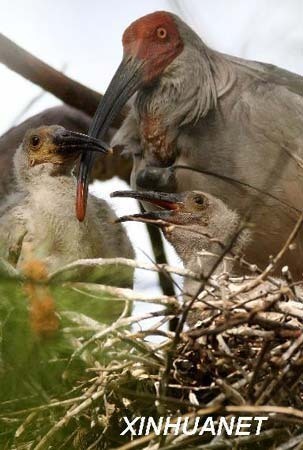Three crested ibises hatched recently in Ningshan County in northwest China's Shanxi Province.
The hatchlings mark a successful pilot attempt by Chinese researchers to return one of the world's most endangered species to the wild, the Xinhua News Agency reported. Its parents were bred in captivity and returned to nature last May.

A crested ibis, one of the world's most endangered species, feeds its young in Zhujiazui Village, Ningshan County, northwest China's Shanxi Province. [Photo: Xinhuanet]
Chang Xiuyun, vice secretary-general of the Shanxi Wildlife Conservation Association, said his bureau gained valuable experience from observing the breeding patterns of the baby crested ibises. This would help them revive their population in the region, he added.
Li Xia and Liu Xiaojun, employees at a rewilding base for crested ibis in Ningshan County, keep a close eye on the feathered family.
They said the parents of the birds built their nest on a large, pine tree in Zhujiazui Village in Ningshan County. When one bird flies out to find food, the other stays in to protect the nest. They alternate their jobs every hour.
The hatchlings are healthy, and they will be able to fly in 20 to 30 days, Li Xia told Xinhua.
Last May, China sent 26 crested ibises bred in captivity back into the wild. In the following year, wildlife experts will study these birds with the help of radio signal emitters and video monitors.
Zhang Shoucheng, head of the Forest Bureau of Ningshan County, said out of those birds, six returned to the rewilding base by themselves, while five died and three went missing. The other 12 adapted themselves to the wild, even surviving a severe snow storm last winter.
The bureau plans to return a second batch of crested ibises to the wild early next month.
Crested ibis are a protected species in China. It has been listed in the Convention on International Trade in Endangered Species of Wild Fauna and Flora (CITES).
In May 1981, Chinese scientists found the last seven wild crested ibises in the world in Shanxi Province. Since then, the Chinese government and international organizations have worked together to protect the species.
The species' population has increased from seven to over 1,000. 512 of those are in captivity, while the rest can be found on the southern slope of the Qinling mountain range in Shanxi Province.
(CRI May 4, 2008)